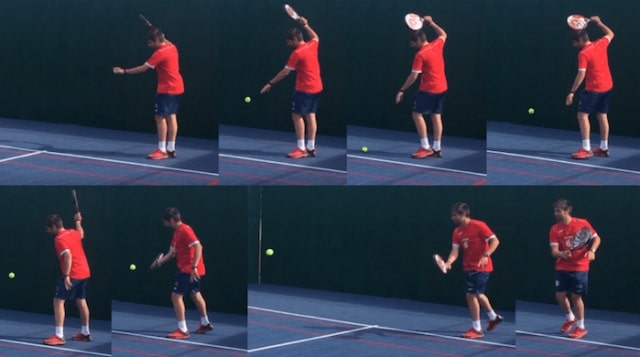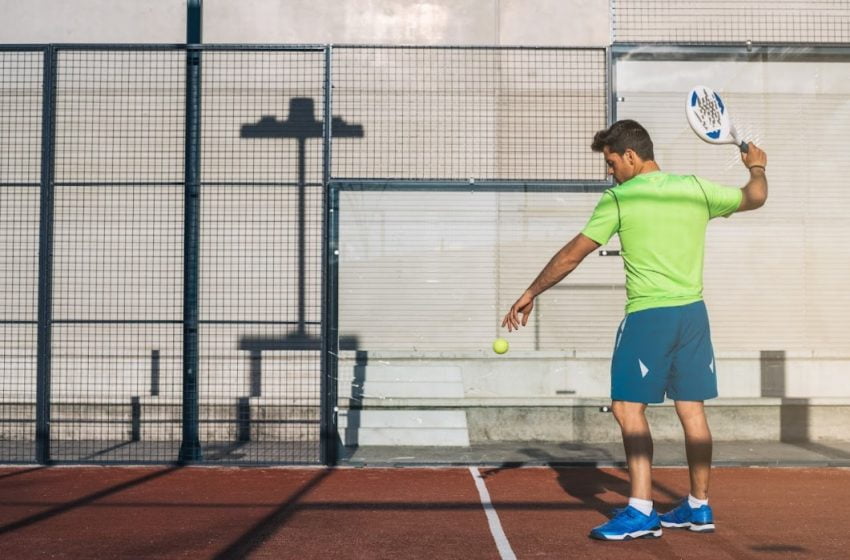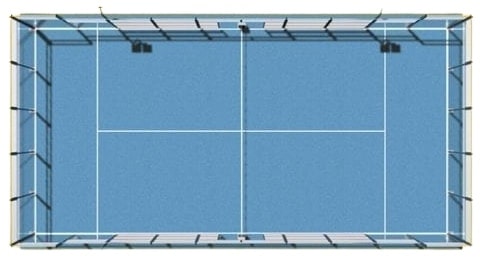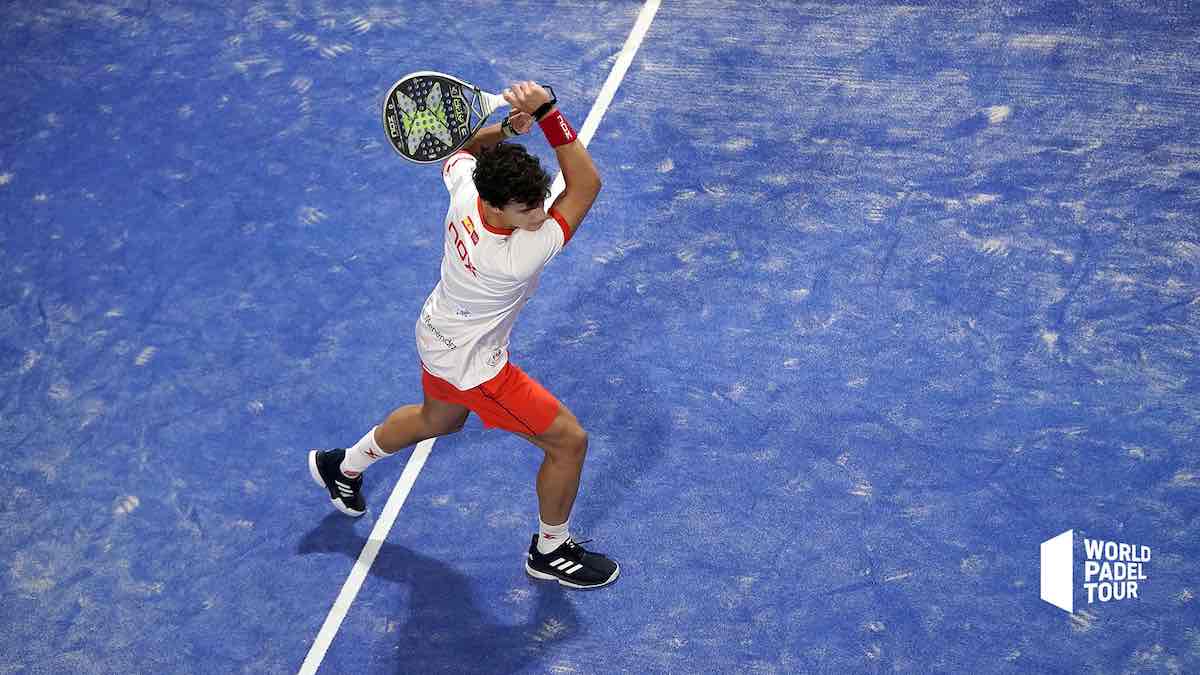Service in padel is not as noteworthy compared to that of tennis. However, practicing the right way to serve the ball is still CRUCIAL in every padel match.
A good serve would help your team take advantage of the net position or even score a point by producing an ace. It’s also the shot that dictates the ball’s direction, spin, and trajectory.
In turn, you have the upper hand in forcing your opponents to press themselves at the back glass. You also have the power to dictate the shot that they’ll use for easy returns.
How padel players serve the ball is quite different from tennis players.
In tennis, you launch the ball up in the air before you serve. But, in padel, you only need to bounce and strike the ball, and you can only do it via an underarm serve.
Another thing to note with padel service is the lines. It’s important to keep your feet behind the service line and not cross the imaginary central line.
You must also hit the ball diagonally towards your opponent’s service box.
These are the BASIC things you must know about a padel serve. But, there are many things to note for you to improve that serve.
Stick with us as we discuss more about padel service. We’ll help you get on the move in your following games.
How to position yourself for the service
It’s important that you position yourself according to the official padel rules by the International Padel Federation.
If not, the referee might call an invalid ball, and you’re bound to lose a point.
You MUST NOT cross the service and center line when you’re the server. You should also remember to position between the central service line and the back.
Also, remember that when serving the ball, you must keep at least one foot on the ground. You are NOT allowed to jump as perform service.
Static vs. dynamic service

When doing a serve, you can do two types of action: static and dynamic.
- Static action means that your feet stay on the ground as you aim to hit the ball. You can also step forward as you serve.
- In dynamic action, you must ensure to hit the ball before the service line. You also have to keep at least one foot on the ground.
As the person serving
When you are the server, you must ensure that you follow the rules to secure good service. If not, your serve will be considered a fault.
Examples of bad service you must avoid include:
- The server misses the ball when serving
- The ball bounces outside the opponents’ service box
- The ball hits the opposing team’s body
- The ball hits the fence of the opponent’s court first
- The ball bounces off the server’s wall before going over the net posts
- The ball bounces incorrectly, and it’s impossible to return
- The player takes more than 25 seconds to serve
If the fault is committed on the first serve, you are still allowed to repeat the shot. This is also referred to as the repetition of a point or let ball.
The first serve is fault if:
- The ball hits the net posts or the net and falls on the opponent’s court
- The ball hits the receiver or their partner’s body
- The server served the ball when the receiver was not yet ready
Other conditions that call for a let ball to be played are the following:
- The ball splits during the game
- The game is interrupted by unforeseen circumstances or elements not part of the official game. In this case, the maximum rest period is also extended over 120-seconds.
Balls may also be changed after an established odd number of games. In this case, the warm-up period is considered as two games and a tie-break one game.
Note:
A faulty second serve causes you to lose a point (e.g. 0-15). But, there are times when the point is not counted (e.g. invalid).
Watch this video to learn more about the padel serve rules:
As the receiver of the serve
At the beginning of the first game, the players will decide who will receive the ball first. This will then be the order followed for the ENTIRE set.
The server is not allowed to serve the ball when the receiver is not yet ready. However, as the receiver, you must also respect the 25-second rule.
In these situations, there’s no point won for both the server and receiver, and the shot is repeated.
Valid service takes place when the ball hits the ground first on the opponents’ court. The ball is also playable if it hits the opponent’s court before hitting the glass.
At this moment, the point begins to be counted for both teams. Until the point is decided, the ball in play continues to be exchanged from both sides of the court.
A return is considered correct if:
- The player returns the ball before the second bounce
- The players did not strike the ball simultaneously, resulting in a double hit
- The opposition player hits the ball back correctly to the opponent’s court
- The ball is scooped, but the player did not hit it twice, and the impact occurs with the same movement
- The ball touches the net and falls on the opponents’ court
- The ball hits the glass or fence after hitting the ground
Incorrect returns may be equal to a point lost. Players must always ensure to return and serve the ball the right way.
Out-of-court play is also possible if authorized by the game officials. In this situation, players can go outside the playing area to hit the ball back.
Out-of-court play is only allowed if the court fulfills the conditions required for the game area.
Note:
If you identify a possibility for a let, you must not hit the ball and call the attention of the umpire (or your opponents if it’s an amateur game).
The umpire can interfere with the game at their own discretion. Interference may happen if the player with deliberate or involuntary action distracts their opponent.
Underarm/underhand serve

The game of padel is always started with an underhand serve. Unlike in tennis, the underhand serve is a must in padel.
To execute the serve, you must bounce or drop the ball low. You’d want to keep it waist level as you hit it with an open racket face.
An open face plus continental grip is VITAL in providing enough height and force to clear the net and strike the ball towards the service box of the opposing team.
You must remember not to add topspin to your underhand serve. Instead, you must aim to add a little slice to create backspin. It keeps the ball low at an appropriate height.
Common mistakes committed by newbies are adding too much spin and trick-serving. This, in turn, results in service errors and inaccurate service.
A padel serve should be simple. This way, you’ll gain more control over the ball’s direction and trajectory.
The backhand serve
Other than an underhand serve, professional padel players sometimes incorporate a backhand serve in their play.
This type of serve can switch the opponents’ rhythm and conversely change the game’s rhythm. It’s also easier to serve using the backhand, especially if you’re used to tennis.
Doing a backhand serve at the left side of the court is also ADVANTAGEOUS for right-handed players to keep the ball closer to the glass.
However, doing such a technique is quite difficult. It’s important that you remain consistent and accurate, especially with your backswing.
A slice is also more effective for a backhand serve. Flats on the backhand are ineffective. Hence, practicing a good slice before performing this technique is important.
To ace a backhand serve, you must:
- Side on to the ball
- Take the racket all the way back for a powerful swing
- Drop and contact the ball in front of your body
How high can you bounce the ball when playing the service?
You are only allowed to keep the ball at waist level or below. You can either bounce or drop the ball in front of your body. But, you must ensure to contact the ball at waist level.
However, you should also note not to hit the target too low. Doing so can make the ball bounce higher than intended on the other side of the court.
The lines that are important in the service
There are a few lines that you must consider when doing service: the service line and the center service line.
When doing a serve, you are not allowed to step on or cross the service line, as well as the imaginary center line.
You should also position yourself between the center line and the back wall.

Can the ball cross the center line after bounce?
The ball is allowed to cross the center line if it’s bounced at the right position. Hence, contacting the ball that crossed the imaginary line is still considered a VALID serve.
Service is diagonal into the opponent’s service box
It’s also important to note that you must serve the ball diagonally. Ensure that the ball lands on the receiver’s service box.
In this case, a player should be stationed at the opposite court where the ball is directed.
The receiver, however, can be positioned at any side of the court as long as the order for return is followed.
The players’ positions should be maintained. However, players must also change ends at every subsequent odd game.
If players did not change sides even after the games played is an odd number, they must rectify the mistake to follow the correct play.
Points garnered before this are still valid and counted.
Service in a tie-break
The first point won is 15, the second point is 30, the third point is 40, and the fourth point is a game.
But, when both teams are tied at 40-40, a deuce is called. The deuce is a tie-break shot where the player needs to score two consecutive points to secure a win.
However, the World Padel Tour introduced the gold point (Punto de Oro) as an alternative scoring method to shorten the tie-break game. The team who wins the deciding point wins the game.
Matches in padel are won with best-of-three sets, where each set is composed of six games. The team must secure a two-game difference to win. Hence, they should get a 7-5 score.
But, if both teams scored 6-6, a tie-break is played.
Players must continue playing to reach 7-6 until a team secures a two-point advantage over their opponents.
Who starts to serve?
The first player to serve in a tie-break is the same player who served the ball at the beginning of a set. They must serve the first point from the right side of the court.
The following two points, on the other hand, are served by players from the opposing court. The following point after the first service is served from the left side of the court.
The order will rotate as usual until the end of the tie-break. The next serving player will serve two consecutive points from the left-hand side and vice-versa until the winner is declared.
How do I improve my serve in padel?
A padel serve is as important as any shot in the game. Once the ball is served, the points begin to be counted.
Hence, improving your serve is critical in securing points during the early game and setting up an advantage for your team.
There are many ways you can do to improve your serve in padel. But, you must always focus on two key things: SPIN and SPEED:
- Too much or too little spin on the ball always results in service faults. You must always ensure the spin is just enough to keep the ball low.
- The speed, however, depends on how accurate you are with hitting the ball. If you feel you can maintain your accuracy after a fast serve, doing so is okay. However, if you think you’re going to lose accuracy, it’s better to keep the ball slow than risking of hitting the fence or glass. It’s also important to work on your slice first if you’re eager to add speed to your serve. If not, there’s a tendency that the ball in play hits the side and back glass first.
Remember:
A simple serve is more consistent and accurate. It’s ideal, especially for recreational players.
Conclusion
A padel serve may not be as noteworthy as is tennis. However, it’s still CRUCIAL to practice good service to take good advantage in the early game.
Playing by the rules, especially in doing a serve, is also vital in every game.
If you want to secure a great padel match, it’s high time to practice your serve.
Remember, keep it simple but accurate and consistent.
Frequently asked questions about the padel service
Service in padel is one of the fundamental shots you must learn before playing the game. If you’re still confused about the serve, we’ll answer a few questions below to help clear things out.
You make sure not to cross the service and imaginary center line. The ball can only bounce within the said area. You must also keep at least one foot on the ground. You’re not allowed to jump or run while serving. But, minimal actions that don’t disrupt the adopted service position are possible. You can do two types of action in padel serve: static and dynamic.
Yes, a second serve is possible in padel. Few circumstances may call for a let and a point repeated.
The ball must only bounce once as the server aims to serve.
To serve like a pro, you must maintain a consistent and accurate serve. You must also improve on your slice and speed to improve your service.
No, you can only do an underhand and backhand serve in padel. When the serving player hits the ball above their waist, it’s considered a service fault.
No, the ball should not bounce twice in the opposite service area or any part of the opponent’s ground. If the ball bounces twice on the opponents’ court, the point is won by the server.
The ball must only bounce & be hit at waist level or below.
During a tie-break, the first to serve is the player who also did the first serve of the set. Usually, it’s played on the right side of the court.

Patricia Nguyen is a former pickleball player who joined SimplePadel as a Content Writer in late 2022. She lives in Texas with her two dogs and is an avid fan of the sport. Her favorite player is Ale Galán, whom she believes to be the best defensive padel player that ever played the game.

18 replies on “Serving Rules Padel”
[…] Your Complete Guide to Serving Rules of Padel […]
[…] Your Complete Guide to Rules of the Serve in Padel […]
[…] height of the ball from the ground and speed affect how well your Padel serve, and spinning can […]
[…] run through the fundamental positions, swinging force, Padel rules of the serve, and ways of ensuring that your service leaves your opponents stumped and your audience […]
[…] It is worth mentioning that this padel racket is suitable for all types of strokes including forehand, backhand and serve. […]
[…] can try to play normal padel but within the service lines as a half court game. This is also a great way of playing padel with […]
[…] Your Complete Guide to Serving Rules of Padel […]
[…] The Complete Guide to Padel Serve Rules […]
[…] Serving rules of Padel […]
[…] The approach of Paquito Navarro on the overall design of the Bullpadel Hack 03 2022 is very personal. Paquito Navarro is a backhand player famous for his ability to attack after defending, and also for his backhand serve. […]
[…] One feature we felt good about the Bullpadel Indiga CTR 22 racket for attacking players is its inner core, which is made of SoftEva rubber, which is great when returning and receiving shots while keeping maximum control. However, it’s quite hard getting the power you need on the serve. […]
[…] The Carbon flex and EVA hitting surface materials allow the racket to make contact with the ball more frequently, improving your spinning and serving abilities […]
[…] extended length and grip size gives the player an advantage on the serve-greater impact, and longer reach for a better speed range […]
[…] below the waist. Similar to tennis, the serve must cross into the opponent’s square. Players serve twice in Padel. However, the receiving player cannot hit a volley, as the ball must bounce […]
[…] Serve and Score is a game that focuses on serving skills and accuracy. Set up targets on the opposite side of the net, assigning different point values to each target. Players take turns serving and aim to hit the targets. The points are awarded based on the accuracy of their serves. This game not only helps kids improve their serving technique but also encourages them to strategize and aim for specific targets to maximize their scores.Source: simplepadel.com […]
[…] Your Complete Guide to Rules of the Serve in Padel […]
A question: If server serves the ball to the for hands rectangle ( pre decided) but the player in the backhand side returns the serve will that cause the receiver players loose point!
That is correct.